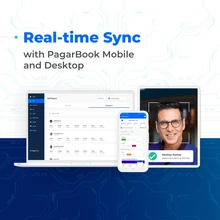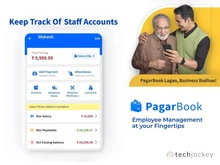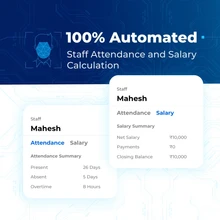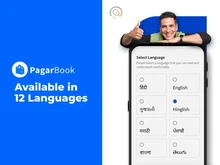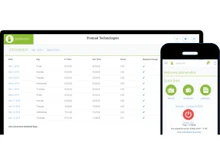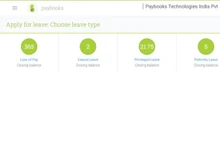PagarBooks and PayBooks emerge as key players in the field of payroll management and HR automation, offering powerful tools to simplify and streamline employee management. Both solutions share a common goal: to provide businesses with robust platforms that make payroll processing, attendance tracking, and compliance management effortless.
While PagarBooks and PayBooks share the mission of improving payroll management, they differ in key functionalities, interface design, and user experiences. We have compared both solutions based on their strengths, ease of use, performance, and more.
PagarBooks vs PayBooks: An Overview
PagarBooks is designed with small and medium-sized businesses in mind, offering a simple and intuitive platform that helps businesses automate payroll, track employee attendance, and ensure compliance. It stands out for its user-friendly design and its focus on providing payroll solutions to companies with minimal HR infrastructure. PagarBooks also includes tools for generating payslips, managing leave, and handling employee records with ease.
PayBooks, on the other hand, is a more comprehensive payroll solution that caters to a wider range of business sizes, from startups to large enterprises. With a more feature-rich platform, PayBooks allows businesses to automate complex payroll processes, calculate taxes, and ensure compliance with various labour laws. It also offers a strong suite of integrations with accounting software and other HR tools, making it a versatile option for businesses seeking a complete HR management solution.
PagarBooks vs. PayBooks: Pros & Cons
PagarBooks Pros:
- User-friendly Interface: PagarBooks offers an intuitive, easy-to-navigate interface, ideal for small businesses or users with limited payroll experience.
- Quick Setup: Minimal HR infrastructure is needed, allowing businesses to set up payroll and employee management processes quickly.
- Affordable Pricing: PagarBooks provides essential payroll management features at a lower cost, making it accessible to small and medium-sized enterprises.
- Basic Compliance Tools: It offers straightforward tax filing and compliance tracking tailored to Indian labor laws, sufficient for small businesses.
PagarBooks Cons:
- Limited Advanced Features: Compared to more feature-rich platforms like PayBooks, PagarBooks lacks advanced functionalities such as detailed tax computations and multiple integrations.
- Restricted Integration Options: PagarBooks has fewer integration possibilities with third-party applications like accounting and HR systems, limiting its versatility.
- Compliance Updates: Automated compliance and tax updates are not as comprehensive, potentially leaving room for manual oversight.
PayBooks: Pros & Cons
PayBooks Pros:
- Advanced Payroll Features: PayBooks provides a wide array of payroll automation tools, including tax calculations, compliance management, and multi-level approval systems.
- Comprehensive Integrations: Seamless integration with various accounting platforms and HR tools makes PayBooks a robust solution for larger businesses.
- Automated Compliance Updates: It automatically updates tax regulations and labour law compliance, reducing the risk of penalties.
- Extensive Reporting Capabilities: PayBooks offers detailed reporting and analytics, allowing businesses to track payroll costs and optimize their HR processes.
PayBooks Cons:
- Complex Interface: The feature-packed platform can be overwhelming for smaller businesses or users who prefer simplicity, requiring more time to master.
- Higher Cost: With its wide range of advanced features, PayBooks comes with a higher price point, which may not be feasible for smaller organizations.
- Longer Setup Time: PayBooks’ complexity requires more effort in the initial setup compared to the quick, out-of-the-box nature of PagarBooks.
PagarBooks vs PayBooks: In Terms of Features
- Payroll Processing: PagarBooks provides essential payroll processing features, allowing users to manage salaries, generate payslips, and track employee attendance efficiently. In contrast, PayBooks offers advanced payroll processing capabilities, including automated tax calculations, multi-state payroll support, and customizable payroll reports tailored to specific business needs.
- Compliance Management: PagarBooks ensures basic compliance with Indian labor laws and provides simple tools for tax filings. PayBooks, however, goes a step further by automating compliance updates and offering in-depth features to ensure adherence to complex labour regulations, making it more suitable for businesses with diverse compliance requirements.
- Reporting and Analytics: PagarBooks includes basic reporting features that cover essential payroll metrics. PayBooks, on the other hand, offers extensive reporting capabilities, including customizable reports that provide in-depth insights into payroll data, helping businesses make informed decisions.
- Attendance Management: PagarBooks includes basic attendance tracking features, enabling users to monitor employee attendance and leave requests. PayBooks offers advanced attendance management tools, including integration with biometric systems, detailed reporting on employee attendance patterns, and automated leave management processes.
PagarBooks vs. PayBooks: Customization
PagarBooks offers a robust customization feature that allows users to tailor the software to their specific business needs, including personalized invoices, reports, and templates. In contrast, while PayBooks does provide some degree of customization, it is relatively limited compared to PagarBooks. Users may find the customization options in PayBooks to be straightforward but lacking the depth offered by PagarBooks.
PagarBooks vs. PayBooks: User Friendliness
PayBooks stands out as more user-friendly than PagarBooks, boasting a clean and intuitive user interface that simplifies navigation for users of all experience levels. The onboarding process in PayBooks is seamless, allowing new users to quickly acclimate to the software. PagarBooks, while functional, may require a steeper learning curve for some users due to its extensive features.
PagarBooks vs. PayBooks: Performance
Performance-wise, PayBooks is designed to be efficient and responsive, making it an excellent choice for businesses operating on lower-end hardware. PagarBooks, while powerful, can sometimes demand more resources due to its comprehensive feature set, potentially impacting performance on older systems. However, the increased capabilities of PagarBooks can offer significant advantages for businesses that need a wider range of functionalities.
PagarBooks vs. PayBooks: Which is Better?
When it comes to choosing between PagarBooks and PayBooks, both platforms present unique advantages tailored to meet diverse user needs.
PagarBooks stands out with its user-friendly interface and seamless integration capabilities, making it an ideal choice for small and medium-sized businesses looking to simplify their accounting and billing processes. With features like automated invoicing, expense tracking, and real-time financial reporting, PagarBooks ensures that users can manage their finances effortlessly and efficiently.
On the other hand, PayBooks offers robust payroll processing features alongside its accounting capabilities, making it particularly suitable for businesses that prioritize employee management and payroll accuracy.


 21 Ratings & 16 Reviews
21 Ratings & 16 Reviews






